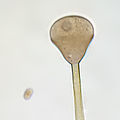Armenian cuisine
(Redirected from Cuisine of Armenia)
Apophysomyces variabilis
Apophysomyces variabilis is a species of fungus in the order Mucorales, which is known to cause infections in humans, particularly in tropical and subtropical regions. This organism is part of the Apophysomyces genus, which includes several other species that are also pathogenic to humans.
Morphology
Apophysomyces variabilis is characterized by its filamentous structure, typical of fungi in the Mucorales order. The hyphae are broad and non-septate, which means they do not have cross-walls. The sporangia, which are the spore-producing structures, are spherical and borne on long sporangiophores. The apophysis, a swelling at the base of the sporangium, is a distinctive feature of this genus.
Pathogenicity
Apophysomyces variabilis is an opportunistic pathogen, meaning it primarily causes disease in individuals with weakened immune systems or those who have suffered trauma. Infections can occur following the inhalation of spores or through traumatic implantation of the fungus into the skin. The resulting condition is known as mucormycosis, which can manifest in various forms, including cutaneous, rhinocerebral, and disseminated infections.
Clinical Manifestations
The clinical presentation of infections caused by Apophysomyces variabilis can vary depending on the site of infection. Cutaneous infections often occur following trauma and can lead to necrotizing fasciitis, a severe soft tissue infection. Rhinocerebral mucormycosis involves the sinuses and can extend to the brain, while disseminated infections can affect multiple organ systems.
Diagnosis
Diagnosis of Apophysomyces variabilis infections typically involves a combination of clinical evaluation, imaging studies, and laboratory tests. Microscopic examination of tissue samples can reveal the characteristic broad, non-septate hyphae. Culture of the organism can confirm the diagnosis, although it may be challenging due to the fastidious nature of the fungus.
Treatment
Treatment of infections caused by Apophysomyces variabilis often requires a combination of surgical intervention and antifungal therapy. Surgical debridement of infected tissue is crucial to remove necrotic material and reduce fungal load. Antifungal medications such as amphotericin B are commonly used, although the choice of drug may vary based on the specific clinical scenario and patient factors.
Related pages
Gallery
Transform your life with W8MD's budget GLP-1 injections from $125.
W8MD offers a medical weight loss program to lose weight in Philadelphia. Our physician-supervised medical weight loss provides:
- Most insurances accepted or discounted self-pay rates. We will obtain insurance prior authorizations if needed.
- Generic GLP1 weight loss injections from $125 for the starting dose.
- Also offer prescription weight loss medications including Phentermine, Qsymia, Diethylpropion, Contrave etc.
NYC weight loss doctor appointments
Start your NYC weight loss journey today at our NYC medical weight loss and Philadelphia medical weight loss clinics.
- Call 718-946-5500 to lose weight in NYC or for medical weight loss in Philadelphia 215-676-2334.
- Tags:NYC medical weight loss, Philadelphia lose weight Zepbound NYC, Budget GLP1 weight loss injections, Wegovy Philadelphia, Wegovy NYC, Philadelphia medical weight loss, Brookly weight loss and Wegovy NYC
|
WikiMD's Wellness Encyclopedia |
| Let Food Be Thy Medicine Medicine Thy Food - Hippocrates |
Medical Disclaimer: WikiMD is not a substitute for professional medical advice. The information on WikiMD is provided as an information resource only, may be incorrect, outdated or misleading, and is not to be used or relied on for any diagnostic or treatment purposes. Please consult your health care provider before making any healthcare decisions or for guidance about a specific medical condition. WikiMD expressly disclaims responsibility, and shall have no liability, for any damages, loss, injury, or liability whatsoever suffered as a result of your reliance on the information contained in this site. By visiting this site you agree to the foregoing terms and conditions, which may from time to time be changed or supplemented by WikiMD. If you do not agree to the foregoing terms and conditions, you should not enter or use this site. See full disclaimer.
Credits:Most images are courtesy of Wikimedia commons, and templates, categories Wikipedia, licensed under CC BY SA or similar.
Translate this page: - East Asian
中文,
日本,
한국어,
South Asian
हिन्दी,
தமிழ்,
తెలుగు,
Urdu,
ಕನ್ನಡ,
Southeast Asian
Indonesian,
Vietnamese,
Thai,
မြန်မာဘာသာ,
বাংলা
European
español,
Deutsch,
français,
Greek,
português do Brasil,
polski,
română,
русский,
Nederlands,
norsk,
svenska,
suomi,
Italian
Middle Eastern & African
عربى,
Turkish,
Persian,
Hebrew,
Afrikaans,
isiZulu,
Kiswahili,
Other
Bulgarian,
Hungarian,
Czech,
Swedish,
മലയാളം,
मराठी,
ਪੰਜਾਬੀ,
ગુજરાતી,
Portuguese,
Ukrainian
Contributors: Prab R. Tumpati, MD

